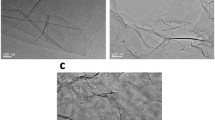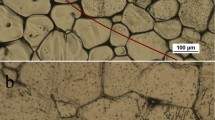Abstract
Graphene oxide–cellulose acetate (GO–CA) nanocomposite membranes have been successfully prepared via phase inversion method. The GO sheets were firstly well dispersed in formamide, and then the solution was mixed with acetone containing CA so as to confirm the GO sheets well dispersed in the final GO–CA nanocomposite membranes. All the GO–CA nanocomposite membranes are composed of dense skin layer and sponge-like sublayer. With the increase in GO contents (from 0 to 0.01 wt%), the skin layer gradually became thinner and the pore size in the sublayer increased; meanwhile, the contact angle of GO–CA membranes decreased from 70.59° to 53.42° due to better hydrophilicity. All the membranes, except for the nanocomposite membrane containing 0.01 wt% GO, have featured pores at about 0.9 nm. The permeation rate of the membrane containing 0.005 wt% GO was 2.3 times higher than that of the CA membrane (0 wt% GO) with a little decrease (~15%) in salt retention. Compared with CA membrane, the enhanced performance of GO–CA membranes may be attributed to their enhanced structure and hydrophilicity.










Similar content being viewed by others
References
Greenlee LF, Lawler DF, Freeman BD et al (2009) Reverse osmosis desalination: water sources, technology, and today’s challenges. Water Res 43:2317–2348
Mezher T, Fath H, Abbas Z et al (2011) Techno-economic assessment and environmental impacts of desalination technologies. Desalination 266:263–273
Ferjani E, Lajimi RH, Deratani A et al (2002) Bulk and surface modification of cellulose diacetate based RO/NF membranes by polymethylhydrosiloxane preparation and characterization. Desalination 146:325–330
Arthanareeswaran G, Thanikaivelan P, Srinivasn K et al (2004) Synthesis, characterization and thermal studies on cellulose acetate membranes with additive. Eur Polym J 40:2153–2159
Saljoughi E, Sadrzadeh M, Mohammadi T (2009) Effect of preparation variables on morphology and pure water permeation flux through asymmetric cellulose acetate membranes. J Membr Sci 326:627–634
Ahmad A, Waheed S, Khan SM et al (2015) Effect of silica on the properties of cellulose acetate/polyethylene glycol membranes for reverse osmosis. Desalination 355:1–10
Abedini R, Mousavi SM, Aminzadeh R (2011) A novel cellulose acetate (CA) membrane using TiO2 nanoparticles: preparation, characterization and permeation study. Desalination 277:40–45
Ali M, Zafar M, Jamil T et al (2011) Influence of glycol additives on the structure and performance of cellulose acetate/zinc oxide blend membranes. Desalination 270:98–104
El Badawi N, Ramadan AR, Esawi AMK et al (2014) Novel carbon nanotube-cellulose acetate nanocomposite membranes for water filtration applications. Desalination 344:79–85
Mohammadi T, Saljoughi E (2009) Effect of production conditions on morphology and permeability of asymmetric cellulose acetate membranes. Desalination 243:1–7
Wang Z, Ma J, Liu Q (2011) Pure sponge-like membranes bearing both high water permeability and high retention capacity. Desalination 278:141–149
Chuang WY, Young TH, Chiu WY et al (2000) The effect of polymeric additives on the structure and permeability of poly(vinyl alcohol) asymmetric membranes. Polymer 41:5633–5641
Chae H, Lee J, Lee C et al (2015) Graphene oxide-embedded thin-film composite reverse osmosis membrane with high flux, anti-biofouling, and chlorine resistance. J Membr Sci 483:128–135
El-Saied H, Basta AH, Barsoum BN et al (2003) Cellulose membranes for reverse osmosis Part I. RO cellulose acetate membranes including a composite with polypropylene. Desalination 159:171–181
Rustemeyer P (2004) History of CA and evolution of the markets. Macromol Symp 208:1–6
Kim Y, Noh Y, Lim EJ et al (2014) Star-shaped Pd@Pt core-shell catalysts supported on reduced graphene oxide with superior electrocatalytic performance. J Mater Chem A 2:6976–6986
Sabir A, Shafiq M, Islam A et al (2015) Fabrication of tethered carbon nanotubes in cellulose acetate/polyethylene glycol-400 composite membranes for reverse osmosis. Carbohyd Polym 132:589–597
Wang Y, Yang L, Luo G et al (2009) Preparation of cellulose acetate membrane filled with metal oxide particles for the pervaporation separation of methanol/methyl tert-butyl ether mixtures. Chem Eng J 146:6–10
Dai HW, Xu ZJ, Yang XN (2016) Water permeation and ion rejection in layer-by-layer stacked graphene oxide nanochannels: a molecular dynamics simulation. J Phys Chem C 120:22585–22596
Sun P, Zhu M, Wang K et al (2013) Selective ion penetration of graphene oxide membranes. ACS Nano 7:428–437
Medhekar NV, Ramasubramaniam A, Ruoff RS et al (2010) Hydrogen bond networks in graphene oxide composite paper: structure and mechanical properties. ACS Nano 4:2300–2306
Aba NFD, Chong JY, Wang B et al (2015) Graphene oxide membranes on ceramic hollow fibers—microstructural stability and nanofiltration performance. J Membr Sci 484:87–94
Dreyer DR, Park S, Bielawski CW et al (2010) The chemistry of graphene oxide. Chem Soc Rev 39:228–240
Lee J, Chae H, Won YJ et al (2013) Graphene oxide nanoplatelets composite membrane with hydrophilic and antifouling properties for wastewater treatment. J Membr Sci 448:223–230
Wang Z, Yu H, Xia J et al (2012) Novel GO-blended PVDF ultrafiltration membranes. Desalination 299:50–54
Choi W, Choi J, Bang J et al (2013) Layer-by-Layer assembly of graphene oxide nanosheets on polyamide membranes for durable reverse-osmosis applications. ACS Appl Mater Inter 5:12510–12519
Zhang JW, Jiang DZ (2014) Molecular dynamics simulation of mechanical performance of graphene/graphene oxide paper based polymer composites. Carbon 67:784–791
Kabiri R, Namazi H (2014) Nanocrystalline cellulose acetate (NCCA)/graphene oxide (GO) nanocomposites with enhanced mechanical properties and barrier against water vapor. Cellulose 21:3527–3539
Uddin ME, Layek RK, Kim HY et al (2016) Preparation and enhanced mechanical properties of non-covalently-functionalized graphene oxide/cellulose acetate nanocomposites. Compos Part B-Eng 90:223–231
Wang C, Lan Y, Yu W et al (2016) Preparation of amino-functionalized graphene oxide/polyimide composite films with improved mechanical, thermal and hydrophobic properties. Appl Surf Sci 362:11–19
Nguyen DL, Hippi U, Korhonen JT et al (2011) Enhanced mechanical and electrical properties of polyimide film by graphene sheets via in situ polymerization. Polymer 52:5237–5242
Smolders CA, Reuvers AJ, Boom RM (1992) Micorstructures in phase-inversion membranes. 1. formation of macrovoids. J Membr Sci 73:259–275
He D, Shen L, Zhang X et al (2014) An efficient and eco-friendly solution-chemical route for preparation of ultrastable reduced graphene oxide suspensions. AIChE J 60:2757–2764
Manjikian S, Loeb S, Mccuchan JW (1965) Proceedings of first international desalination symposium, vol 2. Washington, DC, pp 159–173
Cai D, Song M, Xu C (2008) Highly conductive carbon-nanotube/graphite-oxide hybrid films. Adv Mater 20:1706
Cai D, Song M (2007) Preparation of fully exfoliated graphite oxide nanoplatelets in organic solvents. J Mater Chem 17:3678–3680
Zhang J, Yang H, Shen G et al (2010) Reduction of graphene oxide via L-ascorbic acid. Chem Commun 46:1112–1114
Zhang X, Liu Y, Sun C et al (2015) Graphene oxide-based polymeric membranes for broad water pollutant removal. RSC Adv 5:100651–100662
Guillen GR, Pan Y, Li M et al (2011) Preparation and characterization of membranes formed by nonsolvent induced phase separation: a review. Ind Eng Chem Res 50:3798–3817
Baldino L, Sarno M, Cardea S et al (2015) Formation of cellulose acetate-graphene oxide nanocomposites by supercritical CO2 assisted phase inversion. Ind Eng Chem Res 54:8147–8156
Lalia BS, Kochkodan V, Hashaikeh R et al (2013) A review on membrane fabrication: structure, properties and performance relationship. Desalination 326:77–95
Li Q, Pan X, Hou C et al (2012) Exploring the dependence of bulk properties on surface chemistries and microstructures of commercially composite RO membranes by novel characterization approaches. Desalination 292:9–18
Acknowledgements
This research was supported by National Key Technology Research and Development Program (No. 2014BAE12B0104), the National Natural Science Foundation of China (No. 51425202), Natural Science Foundation of Jiangsu Province (BK20160093) and the Industrial Support Program of Changzhou (No. CE20160031).
Author information
Authors and Affiliations
Corresponding authors
Ethics declarations
Conflict of interest
The authors declare there are no conflicts of interest regarding the publication of this paper.
Rights and permissions
About this article
Cite this article
Shi, Y., Li, C., He, D. et al. Preparation of graphene oxide–cellulose acetate nanocomposite membrane for high-flux desalination. J Mater Sci 52, 13296–13306 (2017). https://doi.org/10.1007/s10853-017-1403-0
Received:
Accepted:
Published:
Issue Date:
DOI: https://doi.org/10.1007/s10853-017-1403-0




